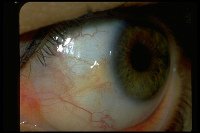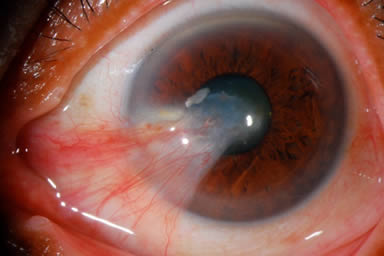Pinguecula Overview

A pinguecula is an abnormal growth on the eye, usually on the conjunctiva. While pingueculas are benign, they can extend on to the cornea, and can impair vision. While the cause is not entirely understood, long-term exposure to UV light, or sunlight, can be a risk factor. They are most common in tropical climates and are more likely to occur among middle-aged and older people.
The condition is more common with age and affects both males and females equally. Its progression is most likely caused by occupational exposure to ultraviolet light and sunlight. Most individuals will show signs of pinguecula by their late 80s. Fortunately, there is no specific treatment for pinguecula. Patients with a history of sensitivity to UV light or other factors can try home remedies and steroid drops. However, pinguecula treatment is not necessary for all cases.
A pinguecula may be painful and may require treatment. If it’s making your eyes uncomfortable, an eye doctor will prescribe artificial tears or drops that add moisture to the eye. The doctor may also prescribe a steroid eye drop or topical anti-inflammatory medications to help reduce the swelling and discomfort. If the condition worsens, an ophthalmologist can also prescribe topical antibiotics to reduce inflammation and alleviate symptoms.
Pinguecula – fibrosis of the eye. It occurs on the cornea near the limbus. It looks like a wedge-shaped area of fibrosis on the conjunctiva. Most people develop pingueculae during their lifetime. Most of them have no symptoms and are harmless. When they do develop, they can be treated with prescription medications or punt plugs. They can also be prevented by wearing sunglasses with UV protection.
Pinguecula is not a dangerous disease. Most people do not experience any symptoms, but may experience irritation or redness. In rare cases, pinguecula can also affect a patient’s vision, but this is not a serious condition. If you notice one or both of these lesions on your eye, see your doctor. If you have vision problems, wear protective glasses to avoid the sun.
Pinguecula is a common eye disease. This is fibrosis of the cornea and can affect vision. Most cases occur in middle-aged and elderly people, but it can also occur in younger people. Although it does not cause any symptoms, it can destroy the tear film that protects the eyes from ultraviolet light. Typically, the affected eye appears as a small yellow spot on the white part of the eye.

Pinguecula is a benign tumor on the eye that does not require treatment. Often pinguecula are not cancerous. However, if this causes discomfort, you should contact your eye doctor immediately. Depending on the location of the growth, site rosetintedtraveler.com
may recommend drops to moisturize the eyes. Your doctor may prescribe topical anti-inflammatory medications. If your doctor suspects a pinguecula, he or she will prescribe topical medications to relieve discomfort.
While pinguecula is often caused by UV exposure, it isn’t usually serious. Most pingueculae are harmless and don’t cause any symptoms. Typically, they are painless, and can be treated with artificial tears. Some patients, however, require surgery. There are several causes of pinguecula. In addition to being an aesthetic problem, pingueculae can cause visual impairment. These factors are essential in determining the cause of the pinguecula.
Although pingueculae are usually harmless, they can lead to other complications. These conditions include nodular scleritis, nodular melanoma, and conjunctival adenomas. Luckily, there are few treatments for a pinguecula, but a specialist can determine the cause and make recommendations. If your doctor diagnoses the condition, you may be able to continue your daily activities, and continue enjoying good vision.
A pinguecula is a thickened area that forms on the white of the eye. The condition is usually milky yellow in color and can encroach on the limbus. In severe cases, it can grow to the cornea and become a pterygium. While the cause of the condition is unknown, it can affect the person’s vision and affect their daily life. Thankfully, it is not dangerous and is easily removed.